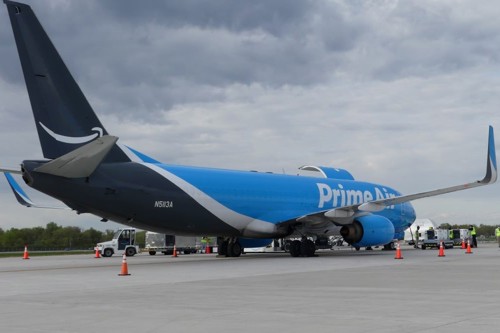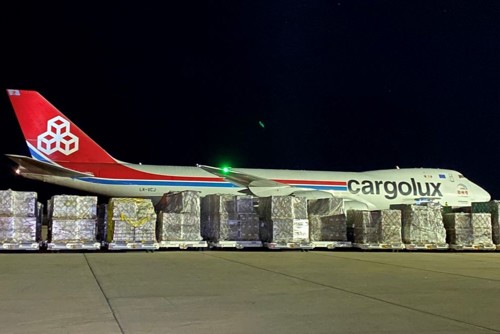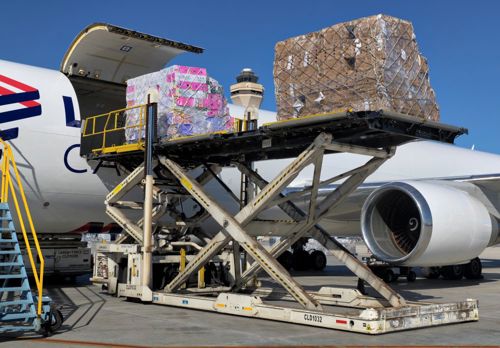
Picture credit: San Bernardino Airport Authority
Located in southern California, San Bernardino International Airport is a relatively new player in the air cargo market, one which has established itself as an express and e-commerce hub.
Since starting cargo operations in 2017, Amazon, FedEx and UPS have established their presence, says Mark Gibb, Director of Aviation at San Bernardino Airport Authority.
Numbers from the Federal Aviation Administration for the full year of 2022 say that San Bernardino airport is number 26 in the USA and it was the fastest grower, up 52%, a figure it is unlikely to achieve again in 2023 but the trend will continue upwards.
The airport measures landed weight reported to the FAA rather than cargo tonnage on aircraft, posting a figure of 1.3 billion pounds of landed weight.
UPS was the first airline to start cargo operations back in 2017 with FedEx following in 2018 and Amazon in 2021.
Gibb says the economic foundations of San Bernardino made it an attractive location for these leading companies with the lowest landing fees in the region and its facilities.
He says, “The availability and the low price point to do business in San Bernardino have been attractive to cargo carriers. We had Fred Smith [FedEx founder and chairman] come down in 2018 and he said I want what UPS has and we said, OK, you’re Fred Smith, you can have that too.”
When cargo operations were established, it grew quickly with the airport constructing a cargo only entrance in 2018 to primarily serve UPS and FedEx.
Roads have been upgraded to separate truck and vehicle traffic and give trucks their own dedicated entrance.
Gibb says, “It has worked very well, we have plugged in a giant tailfin sign off of a 737 to mark the entrance so truckers have an easy time finding it and we created a high-speed off ramp off one of the main arterials near the airport and a queuing area and security checkpoint.”
At the airport, FedEx and UPS occupy old Air Force hangars, which have been modified for cargo operations. Cargo moves in and out on all four sides of the buildings with aircraft able to park adjacent to the hangars, which results in efficient operations.
The Amazon hub is its second largest after Cincinnati/Northern Kentucky International Airport covering 100 acres and it was completely privately financed on land leased from the airport.
It has 41 acres of a structural cargo ramp, a 658,000 square-foot cargo sort facility along two 25,000 square-foot maintenance facilities and 2,000 parking spaces.
As the 26th busiest cargo airport in the US, the target to keep rising, with Gibb commenting, “I am not going to say that we will ever be number one but I believe we will be in the top 20 and we will stay in the top 20.”

Raising awareness
Chicago Rockford International Airport has been an important player in the cargo market for a number of years, hosting UPS flights for almost 30 years and welcoming Amazon in 2016.
Before the pandemic, the airport had been in conversation with other operators who made the move and it turned out to be a good move for them, says Zachary Oakley, Deputy Director of Operations and Planning.
Oakley says, “We had a lot of opportunities throughout Covid to work with airlines, forwarders and shippers who we had been talking to for years and have them experience Rockford.”
Short term, this meant business was good during the pandemic and this is translating into long-term awareness, showing that Rockford is a good place to do business.
This year, Rockford is seeing good movements with Maersk, which has increased services to six times a week, DB Schenker still has a few flights a week coming in, and there are conversations with other carriers about future operations.
In 2022, Rockford moved up a position to the 13th busiest cargo airport in the US with landed weight growing 1%. Just over 100,000 tonnes of international cargo passed through Rockford, adding to 500,000 tonnes of domestic cargo.
Oakley expects a muted peak season and says conversations with operators are good looking into the fourth quarter and into next year.
Being 65 miles by road from Chicago O’Hare makes it hard to grow passenger operations but good for cargo because it is close to one of the most valuable regions in the US.
To improve efficiency, the airport is investing in new taxiways and more parking areas.
Oakley says, “Right now we are five minutes from wheels down to engines off, that is going to be maintained in the future. We don’t have the congestion of the large hub airports so we are going to keep pushing the freighter focus that Rockford is always going to be a freighter-friendly airport.”
This construction season’s big project is Taxiway Papa, a Group Six taxiway for the largest aircraft such as Boeing 747-8s and Airbus A380s, which is adjacent to Rockford’s primary runway and feeds into the international cargo centre.
Oakley says, “Those aircraft will be able to land and taxi directly into a taxiway designed for a B747-8-size aircraft with the proper clearances to allow everything in the airport to keep moving. It is on the south side of the runway, which is where the international cargo centre is located so it is even closer to the facilities.”
This ties into investments made over the last three years in the international cargo centre, says Oakley, which includes six new hard stand positions designed for the B747-8, and three warehouses totalling 240,000 square feet.
Speed is important for express and e-commerce customers, with the Maersk flights coming from China via Anchorage filled with e-commerce products.
Amazon is entirely e-commerce and the last statistic Oakley saw was that around 15% of UPS’s volumes was e-commerce for Amazon.
The two areas Rockford is marketing is sustainability due to its efficient operations and being an e-commerce hub.
“It’s fuel, crew, maintenance and time savings. One of our tenants talks about the ability to use Rockford saves them a minimum of 24 hours in the shipment cycle,” says Oakley.
Looking to the future, Oakley says, “There is a lot of opportunity for growth in Rockford, we are just beginning to scratch the surface in terms of our capabilities. We are taking a look at the next stage, asking how we are going to build the cargo facility of the future that provides the efficiencies and works with types of cargo that are being moved to make Rockford the airport of choice in the Midwest.”

Diversifying business
Serving as the cargo airport for Columbus, Ohio, Rickenbacker International Airport is working on diversifying the types of cargo handled, says Bryan Schreiber, Manager, Business Development Air Cargo.
The main types of cargo passing through Rickenbacker are electronics and technology products, pharmaceuticals and medical equipment, fashion, retail and textiles, automotive parts and live animals.
Schreiber says, “The commodities we are seeing today and are anticipating in the future will be more diverse, less prone to retail downturns and generally higher yielding, and therefore more self-sustaining for our carriers and forwarders.”
The new Rickenbacker Pharma Center has expanded the airport’s portfolio of services. Operated by Alliance Ground International, in partnership with Rickenbacker International Airport, the 9,600 square-foot warehouse is the first dedicated handling facility for temperature-controlled pharmaceutical air cargo shipments in Ohio.
Features of the pharma centre include an acceptance, holding and processing zone kept at controlled room temperature, a cold storage zone, state-of-the-art temperature monitoring, alerting and record-keeping, an office and support area including space for US Customs and FDA operations, and it is in the process of Good Distribution Practice compliance certification.
Rickenbacker is growing as a logistics hub with over 90 million square feet of industrial warehouse space close to the airport and the adjacent Norfolk Southern Rickenbacker Intermodal Terminal. Over 16 million square feet have been added since 2020.
Schreiber says, “We recently completed another phase of the Rickenbacker Parkway corridor along with utility upgrades that will allow for more growth. We are well positioned to take advantage of the high-tech and bio-medical industries that are increasingly calling central Ohio home.”
Rickenbacker is one of the few cargo-focused airports in the world with onsite warehouses, distribution space and dedicated staff ensuring immediate unloading, saving shippers time and money.
“From our scheduled airline partners to short-notice ad-hoc charter operators, the Rickenbacker cargo team works tirelessly to perform and/or coordinate the services necessary for prompt handling and on-time departures,” comments Schreiber.
The central Ohio region has been dubbed the silicon supply chain due to attracting large multinational operations in the semiconductor, high-tech manufacturing for EVs, the bio-medical industries and associate supply chain.
Schreiber says, “These are the types of commodities and industries we will be serving in the future. We are already working with forwarders and transportation partners to prepare to serve these needs.”

Another strong year
Coming off a record three-year stretch, Miami International Airport is looking to maintain its high cargo volumes, says Jimmy Nares, Section Chief, Marketing at Miami-Dade Aviation Department.
In 2021, Miami set an all-time record of 2.75 million tons of cargo, followed by 2.73 million tons in 2022. Up to June, 1.38 million tons of cargo was handled at Miami airport, up 1.26%, and in June, international cargo was down less than 0.5%.
Nares says, “MIA is on pace to approximate its two highest years ever for cargo, if not potentially set a new one.”
Perishable imports are offsetting lower exports, maintaining Miami airport’s position as the leading entry point for US air perishable imports. Last year, Miami airport had 67% of the US market share including 90% of US air flower imports. Another commodity that grew was electrical machinery imports, which were up 17%.
Investing in the future is important; the Miami-Dade County Board of County Commissioners have adopted a capital improvement programme funding up to $6.8 billion of modernisation projects over the next five to 15 years, catering for expected passenger growth to 77 million a year and four million tons of cargo.
Nares says, “A number of cargo buildings at MIA will be expanded, modernised, or demolished for re-build; aprons and taxiway runways will be expanded; and parking stands will be added to the areas of the airport accessing cargo facilities.”
The airport is also working with the private sector on the Vertically Integrated Cargo Community, a multi-level, on-airport cargo warehouse which will double cargo capacity.
Digitalisation is important so the airport is working with the community to implement Cargo Community Systems (CCS) to improve clearance and process the large volumes of transit cargo.
Several companies are piloting CCS or in the final stages of launching their CCS. Nares says the airport will support any CCS adopted by stakeholders as long as it is an open-source system able to communicate with other CCS platforms.
Nares says, “We estimate that within the next three to five years MIA will have many users of the CCS, which will improve our efficiency to process more cargo as hard infrastructure comes online.”
This article was published in the October issue of Air Logistics International, click here to read the digital edition and click here to subscribe.
